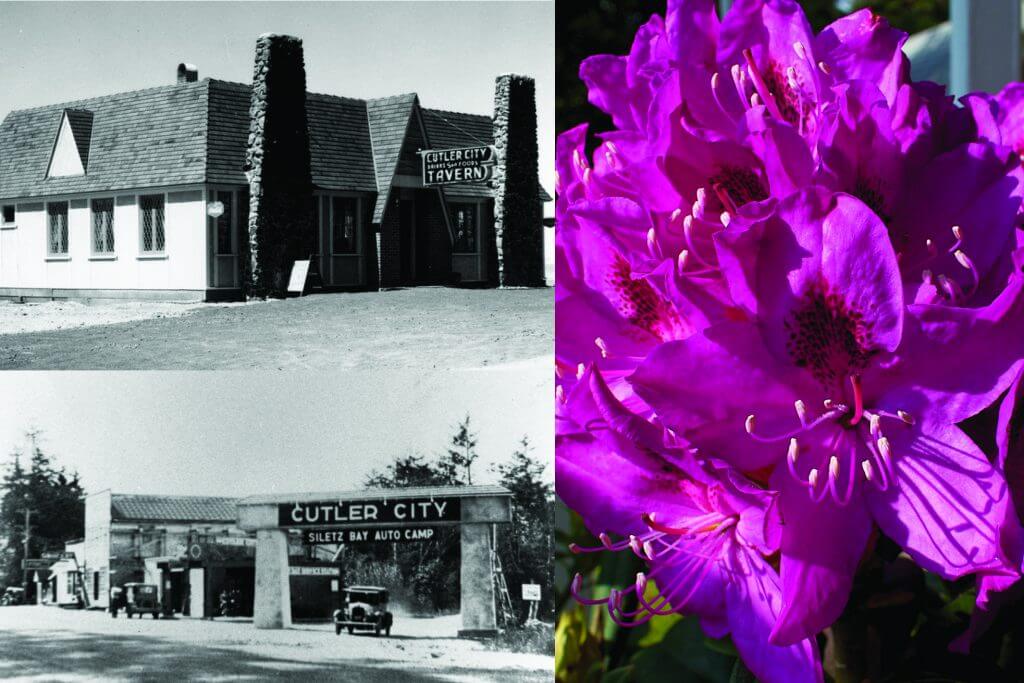Lincoln City Oregon: Cutler City
This is the fourth article in our series regarding the roots of Lincoln City. This article focuses on Cutler City, one of the five original communities of Lincoln City, each with an interesting past.
The Early Days
The Dawes Act of 1887 opened up the Oregon coast to settlers. It provided acreages to new colonists and Siletz tribal members. The promise of free land drew people to the area, but getting there was another matter.
North Lincoln County homesteaders used the old Salmon River route to travel in the area, but it was little more than a trail. It followed the Salmon River, rocky slopes and passed through very deep forest. The abundance of timber and the access to the river made it the ideal spot for the lumber industry, but the road was barely passable and only during the dry seasons of the year. It was hardly an attractive prospect for settlers traveling with all their worldly possessions.
Nonetheless, settlers did arrive. The first non-natives came to Drift Creek in 1896, and by 1905 the first sawmill appeared. Even after many road improvements, the area was still almost inaccessible. You could reach it on horseback, by boat, or by wading across the water at low tide. A swinging foot bridge across Schooner Creek improved access by 1911.
The Cutlers from Dallas, Oregon were the first to purchase land in the area and by 1913 the Lincoln County Court approved the Cutler City town site. Within the next decade, a dairy also appeared near Drift Creek, but the lack of a passable road limited the population. This all changed with the completion of the Roosevelt Military Highway in 1927, linking all Oregon coast cities.
The Automobile Boom
The area was suddenly connected to the surge of automobiles traveling on the newly built highway. Automobile camping soared during the 20’s and by 1930 the town had the official name Cutler City, an archway at its entrance, and its own auto park with picturesque cottages.
Cutler City became known for its stunning rhododendrons and the ideal getaway for a vacation. Consequently, vacation cottages sprang up with picturesque views and quaint gardens. The town progressed slowly through the Great Depression, bringing new residents and new businesses to the area.
The start of World War II brought development to a standstill. Gasoline shortages and blackouts quashed the tourist industry and any events designed to entice people to the area. However, the lumber industry continued to flourish due to the need for timber throughout the war.
Post-War Development
The end of World War II triggered an economic boom in the U.S., and Cutler City came to life again. The population doubled and many new businesses appeared. Cutler City was less affluent than many other towns, but it had a strong, proud, independent working class community.
When discussions began regarding amalgamating Oceanlake, Taft, Nelscott, Delake, and Cutler City residents were reluctant and skeptical. When the proposal final won approval in 1965, Cutler City’s vote was only 73 yes and 69 no, hardly a landslide. Regardless, Cutler City became Lincoln City along with the other communities.
Cutler City Today
Old Cutler City lies between Schooner and Drift Creeks. It is primarily residential, but a few notable historic buildings still stand. The Cutler City Tavern (photo courtesy North Lincoln County Historical Museum) is now the Bay House and the Kangas Brothers Dairy Barn still echo Cutler City’s early days, although they’ve undergone renovations. You’ll also find antique shops, an art gallery, and the relaxing Josephine Young Memorial Park if you need to unwind.
If you’re interested in exploring historic Cutler City, why not stay in a comfortable Lincoln City beach rental with stunning ocean views and high-end amenities. These well-appointed condominiums offer stunning ocean views and high-end amenities including HDTV, wireless internet, an exercise room, a heated indoor pool and a games room, just to name a few.
Posted on 06/02/2017 in Lincoln City # Lincoln City


